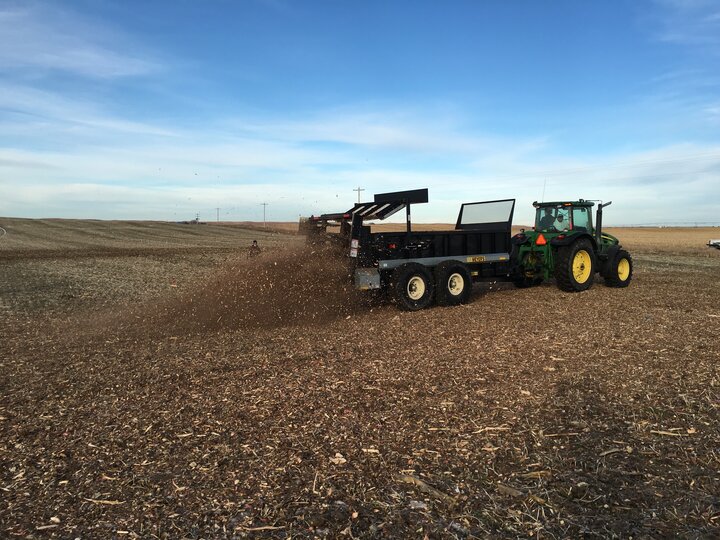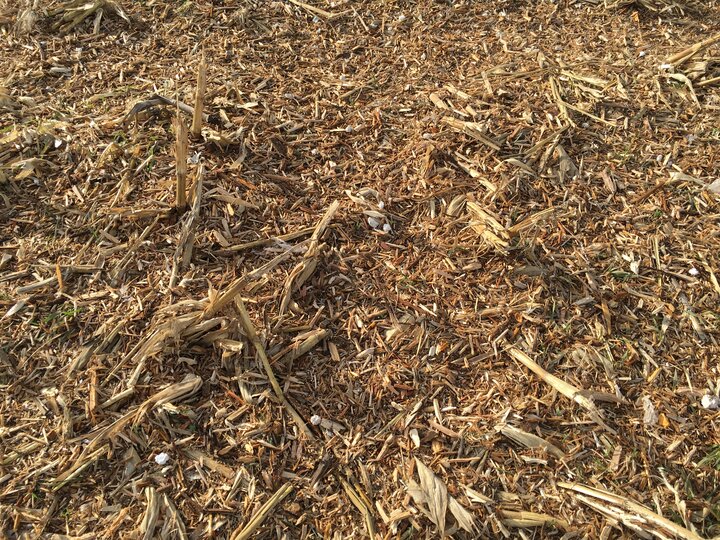Manure and Mulch are Teaming Up
It may seem like an unlikely duo, but livestock manure and cedar tree mulch are coming together in a new statewide research and outreach project intended to improve soil quality and agronomic crop yields. The concept originated in the Middle Niobrara Natural Resources District (MNNRD), headquartered in Valentine, NE, where cedar tree management has been a priority for the past few years. Two members of the board of directors who have utilized livestock manure and multiple conservation practices on their crop fields for many years to improve soil quality questioned whether or not cedar woodchips could add value to their cropping systems as a soil amendment. With access to swine and beef manure, they set out to test the effects on crop productivity of using wood chips mixed with these types of manures. Members of other natural resource agencies in the state encouraged further investigation of this idea and an on-farm research project led by researchers at the University of Nebraska-Lincoln (UNL) was born!
Eastern redcedar trees are a common site in Nebraska. After all, they are a native species in this region of the country and their hardiness makes them a great option for sheltering homes and livestock from wind and weather, so many have been planted for this purpose. But, their hardiness also means they can grow almost anywhere, and that is causing a problem. Cedar trees are spreading into grasslands and reducing forages that support cattle grazing. Their density in some areas is negatively affecting wildlife habitat and they increase wildfire risks due to their flammability. The Nebraska Forest Service is promoting management practices to keep the trees from spreading outside of their usual habitat and into grasslands and areas along the banks of rivers and streams (called ‘riparian forests’).
When cedar trees need to be cleared, prescribed burning or mechanical removal are the primary options. While trees that have been mechanically removed may be useful for cutting into lumber or fence posts, many are piled and burned for disposal. Some studies have researched making biochar out of cedar logs through pyrolysis (a process of decomposing organic material at a high temperature). This study focuses on mechanically chipping branches to create material that is suitable for mulch. The availability of cedar cuttings to produce mulch is abundant; but the utilization of it requires new markets. At a cost of $600 or more per acre to mechanically remove cedar trees, finding a value-added use for this woody biomass is critical to helping offset the cost to landowners of having trees removed.
Manure is also plentiful in Nebraska, which is unsurprising in a state where livestock production contributes over $6 million to the state’s economy (Source). In areas of intensive livestock production, however, over-application of nutrients can occur when insufficient land is available to animal feeding operations (AFOs) to accommodate manure production. While many AFO managers are challenged with managing excess nutrients, application of inorganic fertilizers to nearby cropland represents a net increase of nutrients to the region, contributing to an imbalance and over-application as a whole. Recycling locally available nutrients is an essential strategy to reduce nutrient impacts on Nebraska’s water resources.
When applied responsibly and in the right situations, manure provides important agronomic, soil health, and environmental benefits that go beyond its nutrient contributions to cropland. Research shows that manure improves nutrient cycling and soil aggregation by providing and feeding soil bacteria that break down organic matter, convert nutrients to plant available forms, and produce polysaccharides that “glue” soil particles together to form larger aggregates. These beneficial soil organisms can also help mitigate disease-causing pathogens and pests, while greater nutrient availability increases yield. With its positive impact on soil aggregation, reductions in soil erosion and runoff have been documented for multiple years after manure was last applied.

Since 2015, the two resourceful MNNRD farmers have generously given up a few acres of their fields for UNL researchers to test various applications of mulch alone or co-mingled with cattle or swine manure. That research has answered some important questions: Does the mulch help retain moisture in the soil? Is there any detrimental effect from applying the cedar mulch to cropland? Does the addition of carbon in the woodchips improve soil conditions that contribute to soil health? The answers are: yes, no, and yes! The next step is to test the most promising application rates and mixtures of manure and mulch on cropland in different areas of the state where soil types and soil fertility vary from the sites being used in the Sandhills.
The Nebraska Environmental Trust voted to fund a grant proposal this past spring that is supporting the expansion of this research to six regions of the state. Six Natural Resources Districts have partnered with UNL to facilitate on-farm research with crop farmers in their regions. They are the Middle Niobrara, Twin Platte, Central Platte, Lower Loup, Nemaha and Lower Elkhorn NRDs. Each of these NRDs are working with one or more Nebraska Extension educators in their region to identify an on-farm research site for the studies to take place over the next two years. Study sites will be designed to test three different ‘treatments’ – beef or swine manure, cedar mulch mixed 50:50 by volume with beef or swine manure, and inorganic fertilizer – with each treatment being applied to four plots. These replicated field trials will allow our research team to identify and compare the impacts of each treatment type on soil physical, chemical and biological properties, crop growth, and yield.

These studies are also being used to engage high school students throughout the state in hands-on experiences to learn about agricultural production, nutrient management, soil health, and the role of on-farm research in testing and promoting practice changes to improve agricultural and environmental sustainability. The teams in each participating NRD have identified one or more high school FFA programs within 10 to 15 miles of the on-farm research sites to participate in on-farm research activities and implement related curriculum modules in their classrooms. Our team has a goal of improving the students’ knowledge about these topics, but also encouraging students to consider agricultural degree programs after high school. By engaging them in the outreach activities related to the project, we expect them to gain a better understanding and appreciation for the role of University of Nebraska research and Extension programs in answering applied research questions and sharing new knowledge by communicating the lessons learned with the state’s agricultural producers and others.
This article was reviewed by Rick Koelsch, Todd Whitney, Linda Schott, and Rich Woollen